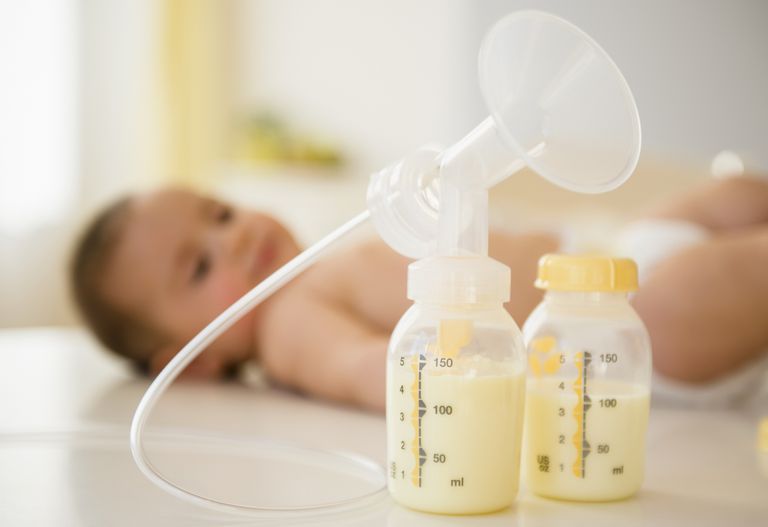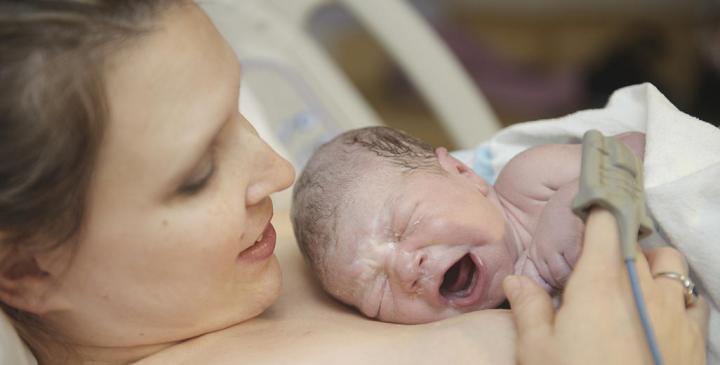Breastfeeding after cesarean section may be difficult due to some problems. They are caused not only by emotions, pain and drugs that a woman takes after surgery, but also by anesthesia. When it comes to breastfeeding after cesarean section, the most important thing is the positive attitude of the mother and a great desire to breastfeed her newborn baby.
Can an operation interfere with breastfeeding?

Many women are concerned about the question of whether it is possible to breastfeed after a cesarean section. The belief that such childbirth is an obstacle to breastfeeding is widespread. Meanwhile, this is a myth that dates back to the days when little attention was paid to the preservation of breastfeeding after surgical delivery.
Childbirth is not the beginning of lactation, but the urge to strengthen it. Milk production begins already at the 16th week of pregnancy. Regardless of how the birth took place, removal of the placenta from the uterus is a signal for the brain to begin secretion of a large amount of prolactin, which is responsible for increased lactation. Frequent application of the baby to the chest is required, which will regularly stimulate the secretion of prolactin and oxytocin.
Without the help of medical personnel, a woman after surgery really has little chance of successful breastfeeding. In addition, if general anesthesia is used during surgery, the patient regains consciousness for a rather long time, and the child has a weakened sucking reflex if it is not applied to the chest on the first day.
Today, most of the planned procedures are performed using spinal anesthesia, during which the woman is conscious. Therefore, the first contact with the baby, which is extremely important for feeding, can be made shortly after childbirth.
It is important that the woman does not allow herself to be convinced that breastfeeding after cesarean section will be impossible for her. You can not succumb to the psychological pressure of others. Experienced midwives say that if a woman decides that she will feed her baby in a natural way, then nothing and nobody will stop her.
Caesarean section may delay lactation somewhat
The hormones responsible for lactation are prolactin and oxytocin. After natural childbirth, the concentration of these hormones in the body gradually increases and with frequent application of the baby to the breast, the lactation process quickly settles in the first day.
Full breastfeeding after cesarean most often begins from 3 to 7 days after birth. This is affected by:
- poor health of the woman (after the operation, feeding the baby on the first day is impossible);
- Separate stay of mom and baby in the hospital.
The rate of “arrival” of milk also depends on the quantity and type of drugs used during childbirth, and on the time of recovery of the female body.
What to do with breast after cesarean?

To maintain lactation, it is necessary to use methods to increase the secretion of oxytocin. Its release is stimulated by breast massage and direct contact with the newborn. If the latter is impossible on the first day after surgery, the midwives encourage young mothers to use a breast pump. It can help in the rapid regulation of the lactation process and the preservation of milk during prolonged separation of the mother from the baby. Some hospitals have electric breast pumps that help you quickly and easily collect colostrum and milk.
Successful feeding after cesarean section

It would be ideal if the baby was applied to the breast within 6 hours after surgery. This is possible if a cesarean section is performed under spinal anesthesia - then skin-to-skin contact and the first feeding can take place even in the operating room (some hospitals practice this) or immediately after the patient is taken to the postoperative room. For these reasons, surgical delivery should be carried out, if possible, under spinal (epidural, or subarachnoid) anesthesia. After general anesthesia, more time passes before the mother wakes up and can make contact with the baby. But remember that delaying the start of breastfeeding does not cancel it in the future.
Help from medical staff
For breastfeeding after cesarean to be successful, first of all, the baby must be with her mother all the time. Unfortunately, it happens that they are separated, despite the good condition of both. A woman after cesarean section needs help - she has the right to count and ask that nurses help her with the first feeding more than mothers after natural birth. As a rule, a woman after the operation feels much worse: she has a headache and a wound on her stomach, pulling stitches, she cannot move - it is impossible to even turn on her side immediately after the operation, in addition, she is connected to a dropper.
So that a woman can feed, someone must give her a baby and properly arrange her so that this does not burden the wound on her stomach. Much depends on the help of the staff of the medical institution. In addition to the direct help of the mother, the hospital should use analgesics that penetrate into breast milk as little as possible (preferably in the lumbar region). On the other hand, if you are taking any medications so as not to harm your child, you should always consult your doctor.
In what position is it better to feed the baby after cesarean section?

The first feeding should occur while lying on your back. Mom leans back against the pillows, and the newborn lies on his stomach over a surgical wound. The baby is supported by the mother’s hand and rests on the pillows so that his head is at chest level. When the mother can turn to the side, it will be more convenient to feed, lying on her side: the child lies next to the mother (the tummy is facing the stomach), resting on her hand In this position, the baby does not compress the wound on the stomach, which is very important (this should not be remembered less than a few weeks). For a woman who prefers to sit rather than lie down, the position of the child “under the arm” will be more convenient - the baby does not touch the belly of the mother. The child is laid on a flat pillow or folded blanket.
Why doesn't the baby want to suck?
A baby is born with a sucking reflex. However, childbirth with the use of strong pharmacological drugs can weaken this reflex, then the baby becomes drowsy and refuses to cooperate. In this case, do not allow the baby to sleep during the first feeding and lay it on the chest, even if it is not required. Sometimes he protests before taking the breast, or simply holds it in his mouth without sucking movements. As a result, it swallows only what has leaked out and does not stimulate lactation. Usually calm and patiently repeated feeding attempts bring results, and the baby finally begins to suck. If possible, use the help of a breastfeeding consultant who will show you how to properly place your newborn on your breast.
Waiting for milk
After childbirth, in every woman’s chest (not only after cesarean section) there is a yellow colostrum that drips in drops. Many nulliparous mothers take this natural phase of lactation for a lack of milk and give their baby a mixture for feeding newborns. And often this causes a lot of problems. The baby is less likely to suckle and does it wrong (due to a closer acquaintance with the bottle). As a result, nipple injuries form, and the breast produces less milk (the mammary gland receives a false signal with little “demand”). Also, in many women, due to ignorance of how to establish breastfeeding after cesarean section, a painful stagnation of milk forms.
Meanwhile, the first drops of colostrum are priceless for the health of the newborn, and its quantity is enough to satisfy its hunger. Often and properly sucking, the baby “starts” the lactation and adjusts it to fit your needs. Of course, mother and baby must learn "milk" cooperation. Onset can be difficult, regardless of whether birth occurred naturally or by caesarean section.
How often to feed a newborn baby?

How much a newborn should eat and how often it is applied to the chest depends on his appetite. The baby should be fed on demand. He himself requires food - he wakes up, cries, stretches his tongue, sucks, moves his mouth, puts his hands in his mouth, reflexively searches for his mother's breasts. A newborn baby can consume food every 2-3 hours, at least every 4 (also at night). His stomach volume is very small (about 7 ml), so in the first days of his life he eats up colostrum. You do not need to feed him with mixtures, thinking that he is hungry. Colostrum has a rich and nutritious composition and satisfies all the nutritional needs of the newborn for a given period of time. For 10-12 attachments to the chest during the day, he can eat up to 100 ml of milk.
The older the child, the longer the breaks between feedings and the less the number of nightly applications, but the larger the portion of food eaten. A child at 2-4 months usually needs 5-6 meals a day with an average volume of 120-140 ml, at the age of 5-8 months - 5 meals (average serving size 150-180 ml), at 9-12 months - 4-5 servings with an average volume of 190-220 ml.
The fact that the child is eating is evidenced by the sound of swallowing and a feeling of relief in the chest. Usually, one feeding takes about 15-20 minutes.
From 5-6 months, the child should introduce additional nutrition to mother's milk or infant formula. The volume of food and the frequency of feeding are regulated by the baby, while the parent is responsible for ensuring that the nutrition is complete and properly composed.
Diet after cesarean section - what can I eat after childbirth?
During the first three days after surgery, a woman is usually connected to a dropper to strengthen and enrich the body with lost substances. It is advisable to avoid solid foods on the first day after birth. Many ask what can be eaten after a cesarean section to the patient, as soon as she comes to herself from anesthesia. Drink plenty of fluids, preferably still water. It can be diluted with fruit juice in a proportion of 100 ml per 1 liter of water. It is important to avoid consuming carbonated drinks, which can cause bloating and abdominal pain.

If the operation went without complications, in the following days the diet is gradually expanded. The patient can:
- drink meat broth in chicken or beef, with a small addition of vegetables;
- low-fat meat (chicken or beef) - it should be boiled, then scroll through a meat grinder and beat to the consistency of mashed potatoes or soufflé;
- fat-free cottage cheese;
- natural yogurt;
- drinks - juice, weak tea, fruit drinks, broth of wild rose, kissel, compote.
Basic principles of postpartum diet

Postpartum nutrition requires compliance with the following principles:
- The patient's diet should include a large number of vitamins and minerals that accelerate wound healing, strengthen immunity, support body regeneration, restore skin elasticity and protect against anemia after pregnancy. The most important of them are: vitamins A, E, C, group B, iron and calcium.
- The postpartum diet should be rich in useful protein, which is responsible for faster regeneration of the body and supports healing processes. Best sources: meat, fish, eggs and dairy products.
- Ready meals should be easily digestible. Therefore, the recommended cooking methods: boiling in water, steaming, stewing without frying, baking in foil or parchment without adding fat and frying without fat. Avoid frying or stewing, during which a large amount of fat is used.
A diet after cesarean section requires the addition of products containing a large amount of iron in the daily diet. Many women suffer from iron deficiency after pregnancy due to the large loss of blood that occurs during childbirth. Its lack can cause weakness, fatigue, drowsiness, or apathy.
Consider what you can eat after a cesarean section to make up for iron deficiency in the blood. Products containing it in large quantities include:
- offal and red meat, as well as poultry, for example, liver, beef, chicken, turkey, veal;
- low-fat and oily sea fish, seafood, for example, salmon, herring, cod;
- eggs, especially egg yolks.
Another important component of the diet is calcium. This element, like iron, supports the healing and regeneration of the female body after childbirth. Demand for calcium increases during pregnancy and lactation. He is responsible for regulating blood pressure and affects the proper coagulation of blood and thus reduces the risk of severe bleeding during childbirth. In addition, this element is necessary during pregnancy and lactation for the proper development of the bones and teeth of the child.
Products rich in calcium include milk and dairy products, which means: yogurt, kefir, cottage cheese, cheese. In addition, calcium is found in fish products, nuts, and green vegetables. The source of this element is mineral water.
When compiling a diet, pay attention to the need for energy, which during the first 6 months of breastfeeding increases by about 500 kcal / day.
What can not be eaten after surgery?
First of all, it is necessary to exclude foods and dishes rich in fats that are difficult to digest. These include: sweets, pastries, fast food, various types of prepared and fried dishes.
In addition, it is undesirable to eat food that causes bloating and abdominal pain. These include: beans, cabbage, onions and sodas. You should also avoid caffeine, so you should not drink coffee, drinks with the addition of caffeine and consume products containing artificial chemicals, such as preservatives, dyes, etc.
Output
Often young women do not know all the intricacies of feeding a baby, so the question of how to breastfeed a newborn is important for them. The process of establishing breastfeeding after cesarean section is not very different from feeding after natural birth. Surgery may delay the lactation period at the beginning, but does not affect the duration and quality in the future. Success in this matter depends on the desire and desire of the new mother to breastfeed her child. Therefore, you should approach this issue calmly and, if in doubt, seek the help of qualified medical personnel.